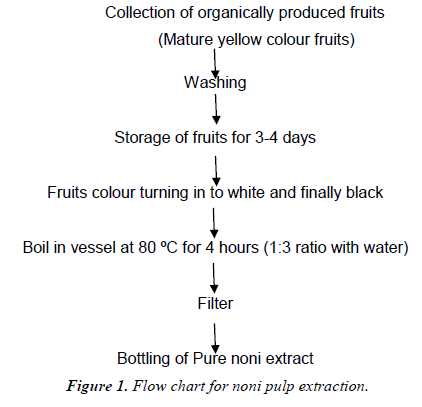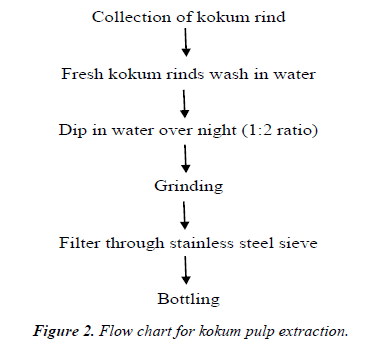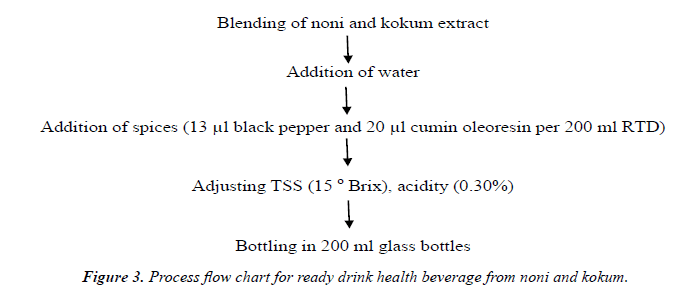Research Article - Journal of Food Technology and Preservation (2022) Volume 6, Issue 1
Development of health and ready to drink health beverage from noni and kokum.
Patil P1*, Thippanna KS1, Jagadeesh SL2, Bhuvaneshwari G1, Rudresh DL1, Kamble A1
1Department of Agricultural Microbiology, University of Horticultural Sciences, Bagalkot, Karnataka, India
2Department of Post-Harvest Technology, College of Horticulture, Bagalkot, Karnataka, India
- Corresponding Author:
- Prasad Patil
Department of Agricultural Microbiology
University of Horticultural Sciences, Bagalkot
Karnataka India
E-mail: prasadpatilalm@gmail.com
Received: 27-Oct-2021, Manuscript No. AAFTP-21-45832; Editor assigned: 01-Nov-2021, PreQC No. AAFTP-21-45832(PQ); Reviewed: 29-Nov-2021, QC No. AAFTP-21-45832; Revised: 22-Dec-2021, Manuscript No. AAFTP-21-45832(R); Published: 18-Jan-2022, DOI:10.35841/2591-796X-6.1.105
Citation: Patil P, Thippanna KS, Jagadeesh SL, et al. Development of health and ready to drink health beverage from noni and kokum. J Food Technol Pres. 2022; 6(1):105.
Abstract
Standardization of blending of noni, kokum extract along with black pepper and cumin oleoresin for the preparation of ready to drink health beverage. The experiment comprised of eight treatments with three replications organized in manner of completely randomized design. The combinations of treatments were arranged in to two sets. Set 1 consists of 12.5 per cent and set 2 consists of 15 per cent overall juice content in RTD. First set have treatment combinations T1 (100% NE), T2 (84%NE: 16% KE), T3 (68% NE: 32% KE), T4 (52% NE: 48% KE) and treatment combinations of second set consists of T5 (NE 100%), T6 (80% NE: 20% KE), T7 (70% NE: 30% KE) and T8 (60% NE: 40% KE). Each 200 ml of RTD contained 20 μl cumin oleoresin and 13 μl black pepper oleoresin and blended RTD filled with 200 ml sterilized glass bottles. Among all the treatment combinations, RTD prepared by using combinations of 52% noni extract and 48% kokum extract reached the highest sensory score for overall acceptability (8.01 score out of 9 point hedonic scale) by a sensory panel with acidity (0.33%) and pH (2.83).
Keywords
Noni extract, Kokum extract, Ready to drink, Blending ratio.
Introduction
Fruit beverages are most demandable products in modern days by consumers due to their innate nutritional content, appetizing, refreshing and having high medicinal properties as compare with synthetic drinks [1]. Blending of two or more juices has opportunity develop a new product with unique flavor and taste [2]. Some of the fruits are rich in nutritional and medicinal benefits, but those are not preferred by people due to their insipid taste, off flavour, high acidity and pungent taste. Blending is one of the innovative techniques to overcome these drawbacks and give a way for utilization of such a nutrient rich and medicinal fruits.
Noni (Morinda citrifolia, Rubiaceae) is a tropical fruit which was popularly grown in Polynesia, India and Pacific islands. It was called by several vernacular names like Indian mulberry, nuna and painkiller bush. It is principally used to restore the immune system and also for prohibiting the viral, bacterial, parasitic and fungal infections. Noni juice is rich in ascorbic acid, antioxidant activity, phenolic content and having huge medicinal benefits, but it was ignored by most of the people due to their pungent taste [3].
Kokum (Garcinia indica) is underutilized tropical spice cum fruit crop which was popularly grown in konkan region of Maharashtra, Goa, Karnataka, Kerala and some parts of Gujarat. Kokum is rich in bioactive compounds like HCA (Hydroxycitric acid), garcinol and anthocyanin’s which are having medicinal properties like anti-obesity, anti-ulcer and anticancer properties [4]. It’s also having the peculiar dark red colour, flavour and acidulant taste. So adverse property of noni can be masked by blending with kokum extract, black pepper and cumin oleoresin consequently enhance the sensory qualities and make more palatability. Hence the present investigation undertaken with an objective of to optimize the recipe for an RTD health beverage by blending noni and kokum based on physico-chemical parameters and sensory qualities.
Materials and Methods
The present investigation was carried out at the department of Post-Harvest Technology, College Of Horticulture, University of Horticultural Sciences, Bagalkote, during the year 2019-20. Organically grown noni fruits were procured from farmer’s field in Ramankoppa village, Shivamogga. Kokum rind was collected from farmer of Sirasi, Uttar kannada. Noni fruits which are yellowish to white colour are used for extraction.
Extraction of juices
Note: Table 1, TSS and titratable acidity (%) of all the treatments were maintained at 15 (°Brix) and 0.3 per cent by adding the required amount of sugar and citric acid but the titratable acidity in T4, T7 and T8 are more than 0.3 per cent because kokum concentration is more in these treatments (Figures 1-3).
Treatments |
Juice blend (%) | Sugar (gm) | Black pepper oleoresin (µl) | Cumin oleoresin (µl) | Water (ml) | Citric acid (mg) |
| T1 | 12.5 (100:0) | 28.5 | 13 | 20 | 143 | 248 |
| T2 | 12.5 (84:16) | 28.5 | 13 | 20 | 143 | 228 |
| T3 | 12.5 (68:32) | 28.5 | 13 | 20 | 143 | 140 |
| T4 | 12.5 (52:48) | 28.5 | 13 | 20 | 143 | 0 |
| T5 | 15 (100:0) | 25.8 | 13 | 20 | 140 | 290 |
| T6 | 15 (80:20) | 25.8 | 13 | 20 | 140 | 150 |
| T7 | 15 (70:30) | 25.8 | 13 | 20 | 140 | 0 |
| T8 | 15 (60:40) | 25.8 | 13 | 20 | 140 | 0 |
Table 1. Treatment combinations.
Biochemical analysis
Biochemical properties of blended RTD were determined by following methods. TSS (Total Soluble Solids) measured by hand refractometer at room temperature and expressed in °Brix. pH of RTD measured by digital pH meter. Total titratable acidity was determined by the visual titration method and was expressed in percentage [5].
Sensory evaluation
Organoleptic evaluation of blended RTD was evaluated based on the sensory properties colour, consistency, taste, flavour and overall acceptability by semi trained judges by using 9 point hedonic scale at department of Post-Harvest Technology, College of Horticulture, Bagalkote [6].
Result and Discussion
Total soluble solids (° Brix): Total soluble solids (TSS) of ready to drink health beverage were maintained at 15 °Brix. Hence the treatments were non-significant with each other (Table 2).
Treatments |
Total soluble solids (°Brix) | pH | Titratable acidity (%) |
|---|---|---|---|
| T1 | 15.00 | 2.99 | 0.29 |
| T2 | 15.00 | 2.74 | 0.29 |
| T3 | 15.00 | 2.76 | 0.30 |
| T4 | 15.00 | 2.83 | 0.33 |
| T5 | 15.00 | 2.98 | 0.30 |
| T6 | 15.00 | 2.66 | 0.30 |
| T7 | 15.00 | 2.71 | 0.33 |
| T8 | 15.00 | 2.88 | 0.35 |
| Mean | 15.00 | 2.82 | 0.31 |
| S.Em± | 00.00 | 0.04 | 1.18 |
| CD @ 1% | NS | 0.06 | 0.01 |
Table 2. Frequency and percentage distribution of the rural and urban women according to their Socio-Demographic Characteristics N=200.
NS*-NonSignificant
pH
The highest pH (2.99) was reported in treatment T1 (NE 100%) and it was on par with the treatment T5 (NE 100%) (2.98). Lowest pH (2.66) was recorded in treatment T6 (NE 80% + KE 20%) (Table 2).This might be because of addition of kokum, which reduces pH and increases the acidity and sourness in the drink. Siddharth and Sharma in blended kokum extract - Concord grape juice and Wasker in pomegranate and kokum blended juice found similar results [7,8].
Titratable acidity (%)
The highest titratable acidity (0.35%) was observed in the treatment T8 (NE 60% + KE 40%) followed by T4 (52% + KE 48%) and T7 (NE 70% + KE 30%). Lowest titratable (0.29%) acidity was noticed in the treatment T1 (NE 100%) (Table 2). This might be because of the increase in acidity observed as kokum extracts concentration increases in the treatments (Table 2).
A Similar result was found by Waskar in pomegranate juice blended with kokum juice [8].
Sensory evaluation of blended noni kokum RTD beverage
Colour
Sensory score of prepared noni kokum blended RTD was depicted in Table 3. Colour is a one of the predominant parameters which determines the consumer preference.
Treatments |
Colour and appearance | Consistency | Taste | Flavour | Overall acceptability |
|---|---|---|---|---|---|
| T1 | 7.75 | 7.18 | 7.19 | 7.18 | 7.15 |
| T2 | 7.15 | 7.37 | 7.63 | 7.37 | 7.37 |
| T3 | 7.48 | 7.82 | 7.81 | 7.82 | 7.70 |
| T4 | 8.27 | 8.00 | 7.98 | 8.00 | 8.01 |
| T5 | 7.28 | 7.27 | 7.29 | 7.27 | 7.24 |
| T6 | 7.30 | 7.67 | 7.63 | 7.67 | 7.54 |
| T7 | 8.14 | 7.85 | 7.82 | 7.85 | 7.77 |
| T8 | 8.26 | 7.67 | 7.93 | 7.67 | 7.80 |
| Mean | 7.70 | 7.60 | 7.66 | 7.60 | 7.57 |
| S.Em± | 0.11 | 0.06 | 0.12 | 0.14 | 0.13 |
| CD @ 1% | 0.44 | 0.31 | 0.52 | 0.61 | 0.53 |
Table 3.Effect of noni - kokum blending on sensory evaluation of ready to drink health beverage (based on 9-point hedonic scale)
The treatment T4 (NE 52% + KE 48%) recorded significantly highest score (8.27) which was on par with T8 (NE 60% + KE 40%) and T7 (NE 70% + KE 30%). Lowest score was recorded in T2 (NE 84% + KE16%). The maximum score for colour was observed in treatments which contain more proportion of kokum pulp. It is mainly due to anthocyanin content of kokum juice which enhanced the colour and eye catching appeal of the blended noni kokum RTD. Byanna and Gouda observed similar results in sweet orange and kokum blended RTS beverage [9].
Consistency
The highest score (8.00) for consistency was noticed in treatment T4 (NE 52% + KE 48%) which is significantly on par with other treatments viz., T7 (NE 70% + KE 30%) and T3 (NE 68% + KE 32%). Whereas lowest score (7.18) was observed in T1 (NE 100%) followed by T5 (NE 100%) (Table 3). This is because of noni juice alone is having thin consistency when compared to blended juice and it was less acceptable by the panel. Same kind of results were reported by Siddharth and Sharma in blending of kokum extract with Concord grape juice [7], in sweet orange and kokum RTS [9].
Taste
The value for taste of RTD health beverage given by panelists ranged between likes slightly and dislike extremely. Highest score for taste (7.98) was recorded in treatment T4 (NE 52% + KE 48%) and it was at par with all other treatments except T1 and T5 (Table 3). Whereas treatments T1 (NE 100%) showed lowest score (7.19) followed by T5 (NE 100%).This might be due to the addition of kokum a good sugar acid blend attained and improved the taste of the beverage. Similar findings were observed by Siddharth and Sharma in kokum grape blended juice [7].
Flavour
Flavour is a composite sensation of taste, aroma and mouth feel [10,11]. Significantly highest score (8.00) for flavour was observed in treatment T4 (NE 52%+ KE 48%) which was on par with T8 (NE 60%+ KE 40%), T3 (NE 68%+ KE 32%) and T6 (NE 80%+ KE 20%) and lowest score (7.18) was reported in treatment T1 (NE 100%) followed by T5 (NE 100%) (Table 3). Flavour score is direct correlation with added kokum extract to the RTD. This might be because of more appealing flavour compounds present in the kokum juice. The results are in accordance with findings in sweet orange and kokum RTS [9,12].
Overall acceptability
Maximum sensory score for overall acceptability (8.01) was noticed in treatment T4 (NE 52%+ KE 48%) which was a level with the treatment T8 (NE 60% + KE 40%), T7 (NE 70%+ KE 30%), T3 (NE 68%+ KE 32%) and T6 (NE 80%+ KE 20%) which is depicted in Table 3.
The lowest score was recorded by the treatment T1 (NE 100%) followed by T5 (NE 100%). This is mainly because of maximum score for colour, consistency, flavour recorded in treatment T4.
Conclusion
Juice blending not only improves the sensory quality it also enhance the nutritional properties. It make a way for developing new product. The Kokum juice masks the pungency flavour of noni fruit juice so that its acceptability can be enhanced and its medicinal properties can be retained and utilized. Highest overall acceptability (8.01 out of 9 point hedonic scale) observed in treatment contained 52 per cent noni extract and 48 per cent kokum extract with 15 º Brix TSS found to be best recipe based on sensory panelists.
Conflict of Interests
None
References
- Giese JH. Hitting the spot: Beverages and beverage technology. Food Technol. 1992;7:70-80.
- Deka BC, Sethi V, Parsad R et al. Application on mixtures methodology for beverages from mixed fruit juice/pulp. J. Food Sci Technol. 2001;38:615–18.
- Joshi AA, Chilkawar PM, Jadhav BA, et al. Studies on physicochemical properties of noni fruit (Morinda citrifolia) and preparation of noni beverages. Int J Food Sci Nutr Diet. 2012;1(1):3-8.
- Ranveer RC, Sahoo A. Bioactive constituents of kokum and its potential health benefits. Nutri Food Toxicol. 2017;1:236-44.
- Ranganna S. Handbook of analysis and quality control for fruits and vegetable products. 2nd Edition. Tata McGraw Hilll Publishing Company Ltd. New Delhi, 1997.
- Amerine MA, Pangborn RM, Roessler EB. Principals of Sensory Evaluation of Food. Academic Press. New York. 2012.
- Siddharth, Sharma AK. Blending of kokum extract in Concord grape juice: study on physico-chemical characteristics, sensory quality and storage. Int J Food Ferment Technol. 2013;3(1):79-83.
- Waskar DP. Studies on improvement in color of pomegranate juice by blending with kokum juice. Acta horticulturae. 2011;890:461-64.
- Byanna CN, Gowda IND. Standardization of recipe for sweet orange and kokum blended RTS beverage preparation and storage. Int J Agri Sci. 2013;9(2):561-66.
- Bakalar N. Sensory science: Partners in flavour. Nature. 2012;486(7403):S4-S5.
- Amin AK, Vasudeva KR, Ugalat J, et al. Development of blended RTS from pomegranate and grapes. IJCS. 2018;6(4):3337-41.
- Samarasiri MH, Chandrasiri TA, Wijesinghe DB, et al. Antioxidant Capacity and Total Phenolic Content Variations against Morinda citrifolia L. Fruit Juice Production Methods. Int J Food Eng. 2019;5(4).


